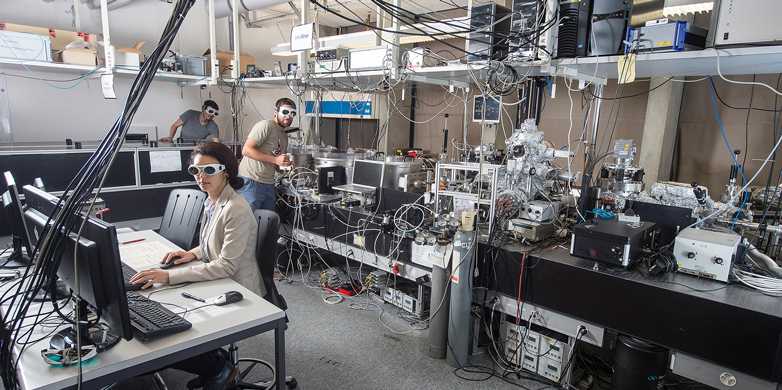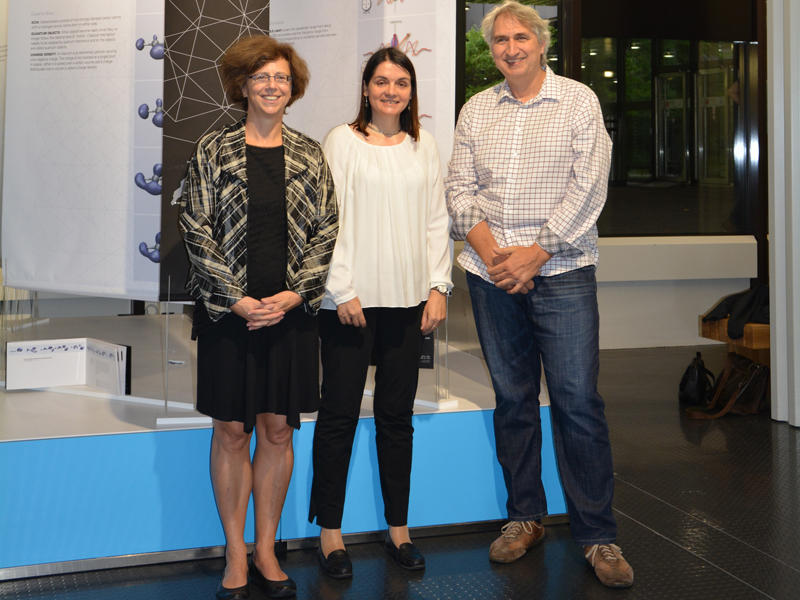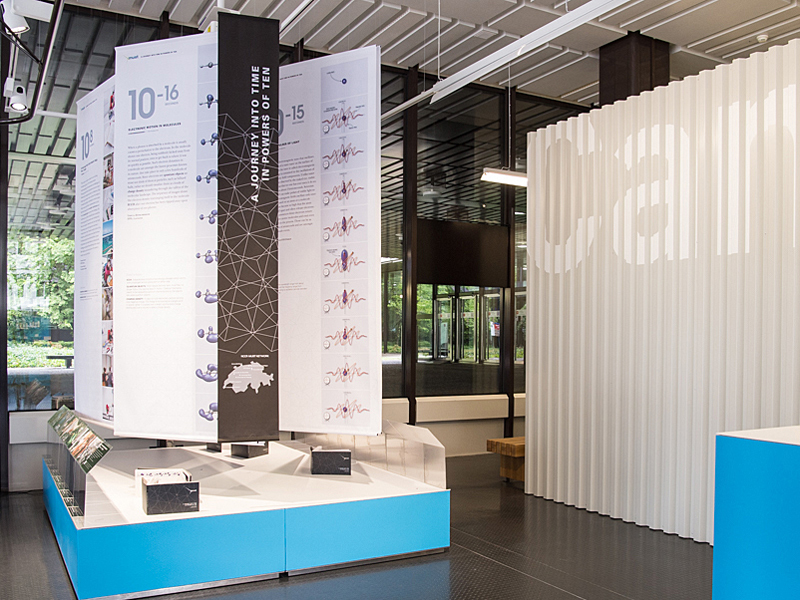Ultrafast processes in the blink of an eye
Ultrafast processes beyond the human imagination occur in nature, but basic research has been able to measure and explore them only since the turn of the millennium. A book and an exhibition by the National Centre of Competence in Research Molecular Ultrafast Science and Technology (NCCR MUST) now connect this to everyday life by inviting you on a journey into time.
The exhibition, which is located in the entrance of Campus Info at ETH Hönggerberg until mid-December, can be enjoyed in no time at all. The name says it all – “Fast”. Several posters present image sequences with processes that take place very quickly – or slowly – and at the same time provide an insight into “ultrafast research”.
Some processes occur so quickly in nature that the blink of an eye is by comparison very slow. A light wave, for example, is ultrafast, rising and falling again in a mere two quadrillionths of a second. In scientific terms, this is two femtoseconds or, when written as the power of ten, 2·10−15 seconds.
Even faster are elementary particles such as electrons or photons: when they move in molecules, it takes an ultrafast 100 trillionths of a second, which is 100 attoseconds or 10−16 s. No one is able to see such ultrafast processes with the naked eye, and even for basic research it is comparatively uncharted territory.
Expanding the horizons of experience
Basic and essential physical, chemical and biological reactions take place in the ultrafast time scale between nanoseconds (10−9 s) and attoseconds (10−18 s). Understanding them can help in the development of alternative sources of energy, new data storage and medical applications, such as artificial blood.
“The human senses perceive light and speed in only a very limited manner,” says Ursula Keller. “This is why we are attempting to expand the horizons of experience through research.” Throughout her career, the ETH Professor of Experimental Physics has contributed to the research to venture into increasingly smaller units of time.
Only since the turn of the millennium has basic research been able to measure and investigate processes in the attosecond range. The breakthrough came thanks to the development of new light sources, such as the new X-ray radar SwissFEL at the Paul Scherrer Institute, based on ultrashort light and laser pulses.
Today, “ultrafast research” comprises subjects such as physics, chemistry, biology and materials science, which are linked together at NCCR MUST. Keller is the co-director of MUST and her Ultrafast Laser Physics group has contributed to the rapid development.
Linking ultrashort research and everyday life
Uncharted territory for research poses a challenge for public communication and the dissemination of knowledge to schools, as neither ultrafast processes nor the research technologies and mathematical notations and models used to explore them are really tangible to lay people.
To establish a link between “ultrashort research” and everyday life, Thomas Feurer, co-director of NCCR MUST and a physics professor at the University of Bern, and Anna Garry, responsible for public communication at NCCR MUST, pursued an idea that had come to Jürg Osterwalder, Professor of Surface Physics at the University of Zurich, while he was on the train.
The idea was to invite non-specialists on a journey into ultrafast processes. The result was the book A Journey into Time in Powers of Ten, as well as exhibitions at Scientifica 2015, the Festival de Science 2016 in Neuchâtel and now at Hönggerberg. The material is also being used in exchanges with schools.
“We would like to make schools and the public excited about our research, inspire them to think about time and the duration of essential processes, and show them how these processes can be expressed numerically,” says Garry, relating how her six-year-old nephew was fascinated by the series of images and immediately asked questions.
The starting point of the journey into time – in both the book and the exhibition – is the blink of an eye: this takes one second or 100 s. In everyday life, blinking is the smallest felt unit in which a human perceives events in their environment. Proceeding from this, the journey travels ten steps from blinking to the attosecond.
Each step corresponds to a power of ten and is connected to one aspect of ultrafast research by a short story. In addition to scientific facts, excerpts from the daily lives of the researchers also appear, rendering numerical reflections about essential processes clear and comprehensible.
Insight into fast and slow processes
A person has a thought in a tenth of a second or 10-1 s. Running 100 metres takes about ten seconds or 101 s. Someone travelling by train from Zurich to Geneva requires 2¾ hours or 104 s. Conversely, lightning takes only 10-4 s.
A doctoral student in their fourth year has put in about 108 s towards their education, whereas a jellyfish in the sea needs only 10-8 s to glow green. “We can easily imagine the step from blinking to sprinting. So when we take these ten steps ten times, we arrive at our research in a way that can be understood,” says Feurer.
“As many people find it much more difficult to imagine powers of ten in the minus range than in the plus range, we have juxtaposed the slow processes with the fast.” The slowest process presented in the book and exhibition is the formation of the Milky Way, which has been dragging on for more than 30 billion years or 1018 s.
Book and exhibition
Anna Garry, Thomas Feurer. A Journey into Time in Powers of Ten. Zurich: vdf Hochschulverlag an der ETH Zürich, 2016. The book is available external pageonlinecall_made and in ETH Store branches.
The exhibition A Journey into Time in Powers of Ten is located in Campus Info in the HIL building, room D 26.5 at the Hönggerberg site. Campus Info is open Monday to Friday from 7.30 a.m. to 5 p.m.



